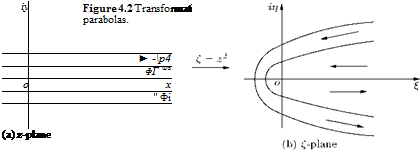Examples of Simple Transformation
The main use of conformal transformation in aerodynamics is to transform a complicated flow field into a simpler one, which is amenable to simpler mathematical treatment. The main problem associated with this transformation is finding the best transformation function (formula) to perform the required operation. Even though a large number of mathematical functions can be envisaged for a specific transformation, in our discussions here, only the well established transformations, which are commonly used in aerodynamics, will be considered. One such transformation, which generates a family of aerofoil shaped curves, along with their associated flow patterns, by applying a certain transformation to consolidate the theory presented in the previous sections, is the Kutta—Joukowski transformation.
Example 4.3
Transform the uniform flow parallel to x-axis of the physical plane, with the transformation function
Z = z2.
Solution
Expressing the transformation function Z = z2, in terms of x and y, we have the following:
Z = z2 = (x + iy)2 = x2 — y2 + 2xiy.
§ + in = X — y2 + i 2xy.
Equating the real and imaginary parts, we get the coordinates § and n, in the transformed plane, as:
22 § = x — y
П = 2xy.
The stream function for uniform flow parallel to x-axis, in the physical plane, is:
f = Vxy.
Therefore:
f
Let f = k.
Vx
Also:
![]()

2y
Therefore, § becomes:
t – П 2 § 4y2 y.
Replacing y with k, we get:
§ = — k2
4k2
or:
П = 2k/ § + k2.
For a constant value of k, this gives a parabola. Therefore, horizontal streamlines, shown in Figure 4.2(a), in the z-plane, transform to parabolas in the f-plane, as shown in Figure 4.2(b). Thus, applying the transformation function f = z2 to an uniform flow parallel to x-axis in the physical plane, we get parabolas in the f-plane.
Note that the flow zones above or below x-axis, in the z-plane, transform to occupy the whole of the f-plane. These zones of the z-plane must be treated separately. In this case, the streamlines in the lower part of the z-plane, extending along the negative y-direction, will be taken with the flow streaming from left to right, in Figure 4.2(b). The streamlines for this flow is given by:
f = Vxy,
where y is always negative. Thus, the stream function is negative in this zone.
![]()
 |
Example 4.4
Find the transformation of the uniform flow parallel to the y-axis, in the z-plane, using the transformation function Z = z2.
Solution
The given flow field is as shown in Figure 4.3(a).
For the transformation function Z = z2, from Example 4.3, we have:
22 Z = x – y
П = 2xy.
The stream function for the downward uniform flow, parallel to y-axis, shown in Figure 4.3(a), is:
ф = VyX.
![]()
 iy■
iy■
o
(a) z-plane
Thus, for a given ф and Vy.
ф
x = — = constant. Vy
Let x = — = k.
Vy
The coordinates § and n can be arranged as follows.
П = 2x fxJ-—§.
Replacing x with k, we get.
For different values of k this represents a set of parabolas, as shown in Figure 4.3(b).











